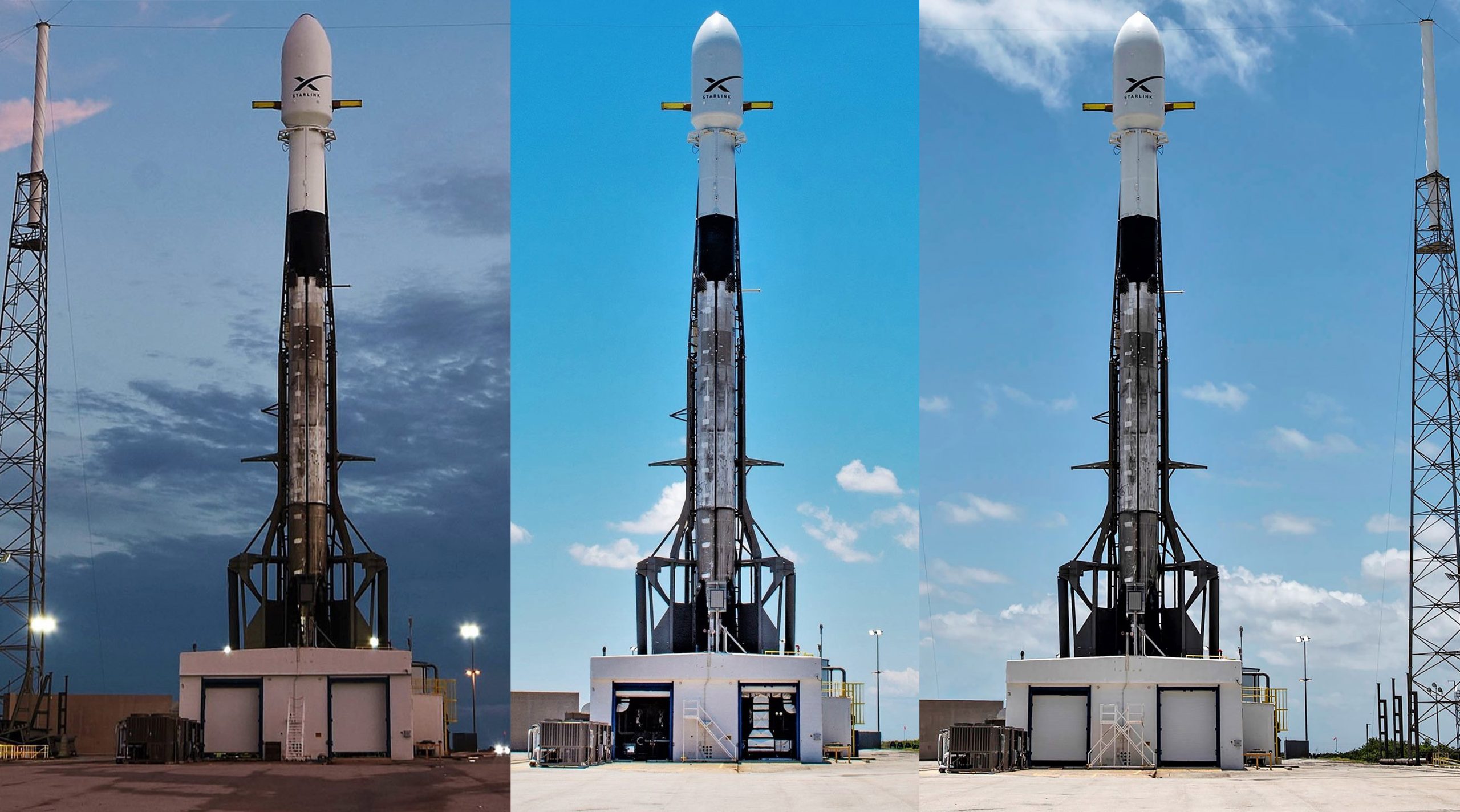
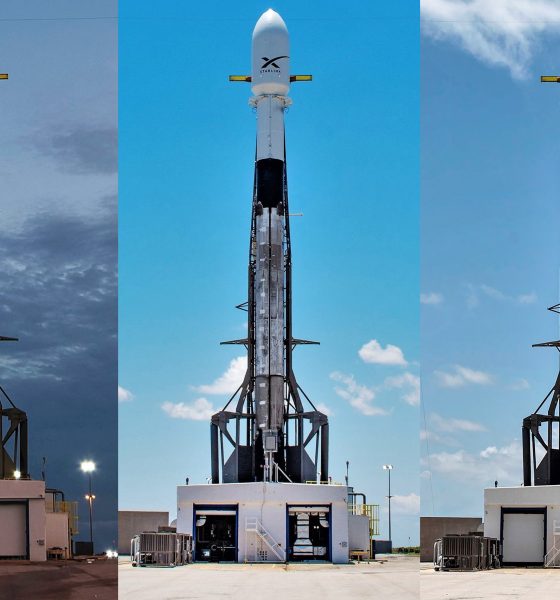
News
SpaceX’s next Falcon 9 missions likely two back-to-back Starlink satellite launches
Hinted at by a launch photographer and confirmed by an article published on NASASpaceflight.com, it appears that SpaceX’s next Falcon 9 launch is at least a month away and will likely be the company’s first operational Starlink mission, deemed “Starlink 1”.
Barring a surprise mission in the interim, this means that SpaceX is going to have a gap of at least two months between customer launches, something the company has not experienced since mid-2015 – more than four years ago. As such, it’s an extremely happy coincidence that SpaceX may now have internal Starlink launches to fill lulls in its commercial launch manifest.
Like any production and services-focused company, SpaceX incurs operational costs whether or not its services are being used – employees, leases, supplier contracts, and more still need to be paid for, facilities still need upkeep, long-lead production can’t simply pause, and many other recurring costs can’t be avoided. In theory, supplementing commercial launches with internal launches thus limits SpaceX’s downtime and effectively increases overall capital efficiency.
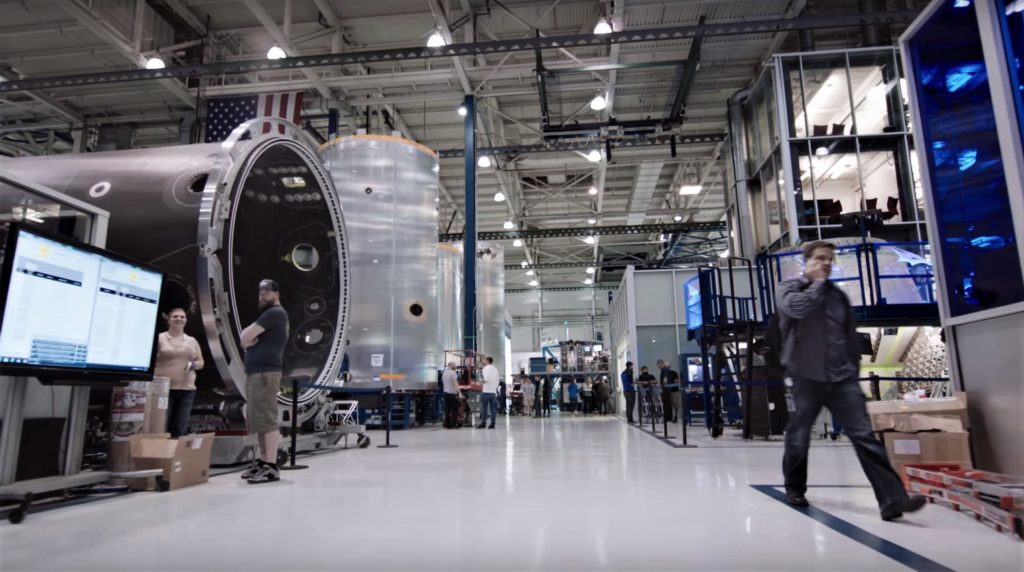
Flatsat revolution
Enter Starlink, a colossal ~11,800-satellite broadband internet constellation nominally designed, manufactured, launched, and operated by SpaceX. On May 23rd, after approximately one week of delays, a twice-flown Falcon 9 booster lifted off for the third time in support of SpaceX’s first dedicated Starlink launch, an unparalleled 60-satellite beta test known internally as “Starlink v0.9”.
Upsetting all expectations, SpaceX managed to fit en incredible 60 high-performance Starlink satellites into Falcon 9’s unchanged payload fairing – middle of the ground in terms of usable volume. Weighing anywhere from 16,000 kg to 18,500 kg (35,300-40,800 lb), SpaceX’s very first dedicated Starlink launch also crushed the company’s record for heaviest payload launched by several metric tons.
In a fascinating turn of events, SpaceX ultimately sided with a largely unprecedented form factor for its operational Starlink satellites, resulting in ultra-thin, rectangular spacecraft that can be stacked like cards and feature their own integrated locking and stacking mechanisms.
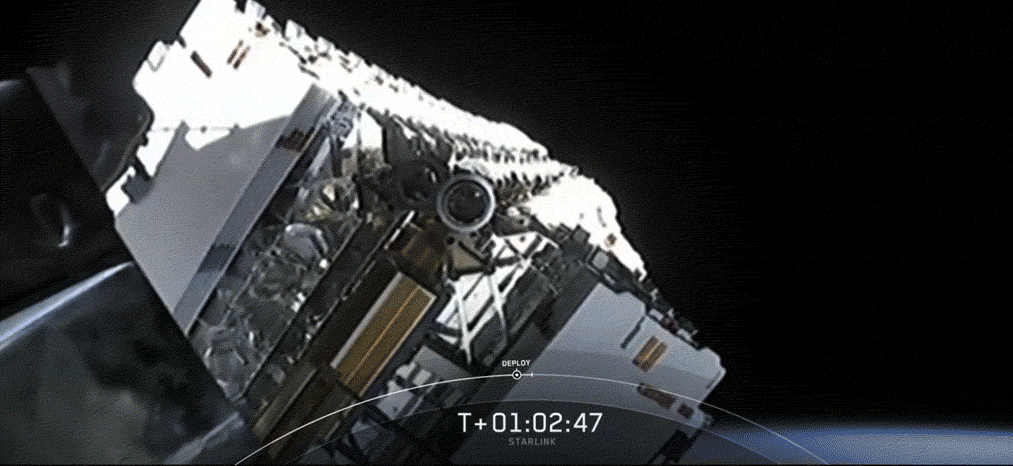
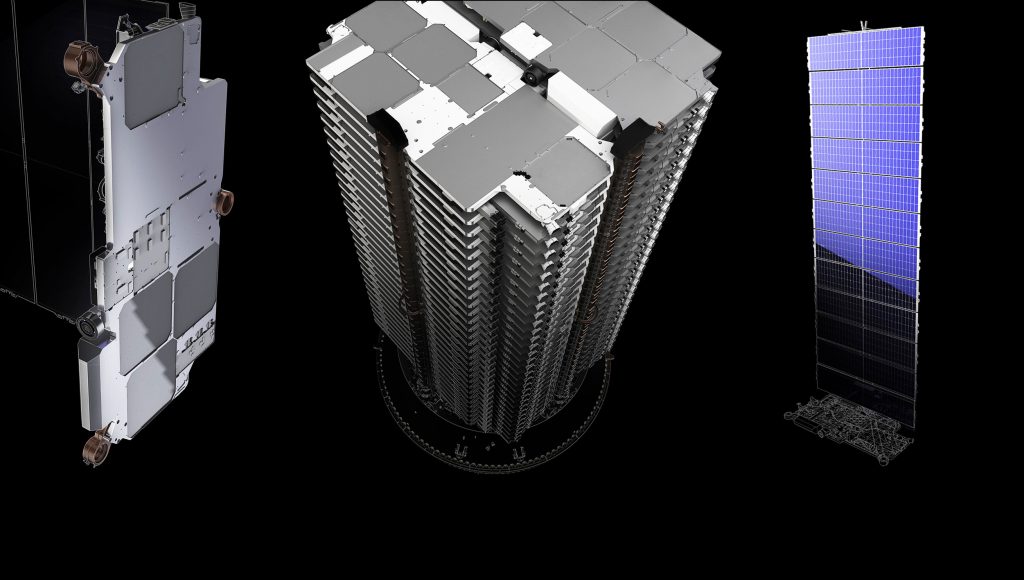
A paradigm shift
According to NASASpaceflight.com, SpaceX’s first and second operational Starlink missions (Starlink 1 and 2) are scheduled to launch no earlier than (NET) October 17th and November 4th, while a similarly trustworthy source puts Starlink 1’s launch date NET “late October”.
Given that Starlink v0.9 was effectively a massive flight test meant to tease out issues with the satellites’ designs, any new any satellites launched in the coming months will have almost certainly been manufactured, assembled, and prepared for flight in just a few months. Unfortunately, out of the 60 satellites launched in May 2019, 10 (16.5%) have been decommissioned for unknown reasons, although the remaining 50 (83.5%) have reached their final orbits and are believed to be in good health.
Put simply, a >15% failure rate is not acceptable for an operational constellation of thousands of satellites, meaning that SpaceX will likely continue to refine and improve its Starlink design before truly ramping up production and launch cadence. Unless the issues leading to multiple satellite failures were relatively simple or expected, the company’s next one (or two) Starlink launches could be closer to “v0.95” than the first fully operational missions. Time will tell.
For now, the fact alone that SpaceX reportedly plans to complete its 180th high-performance satellites barely nine months after beginning high-volume production is dumbfounding. Incredibly, building 180 satellites in 9 months is, by all means, a low-volume run relative to what SpaceX will need to achieve to launch its full Starlink constellation by late 2027. A production rate of 180 Starlink satellites per month is much closer to the necessary production and launch cadences needed for SpaceX’s deployment milestones.

Regardless, for the time being, it appears that odds are good that SpaceX will be able to make good on its promise of launching 2-6 Starlink missions in 2019. According to SpaceX, Starlink can begin offering serious commercial broadband services in regions of the northern US and southern Canada once 360 satellites are safely in orbit.
If SpaceX manages to launch two quasi-operational Starlink missions in the span of a month (Oct-Nov), that initial operations milestone could come just a few months into 2020.
Check out Teslarati’s Marketplace! We offer Tesla accessories, including for the Tesla Cybertruck and Tesla Model 3.

Elon Musk
Elon Musk’s X will start using a Tesla-like software update strategy
The initiative seems designed to accelerate updates to the social media platform, while maintaining maximum transparency.

Elon Musk’s social media platform X will adopt a Tesla-esque approach to software updates for its algorithm.
The initiative seems designed to accelerate updates to the social media platform, while maintaining maximum transparency.
X’s updates to its updates
As per Musk in a post on X, the social media company will be making a new algorithm to determine what organic and advertising posts are recommended to users. These updates would then be repeated every four weeks.
“We will make the new 𝕏 algorithm, including all code used to determine what organic and advertising posts are recommended to users, open source in 7 days. This will be repeated every 4 weeks, with comprehensive developer notes, to help you understand what changed,” Musk wrote in his post.
The initiative somewhat mirrors Tesla’s over-the-air update model, where vehicle software is regularly refined and pushed to users with detailed release notes. This should allow users to better understand the details of X’s every update and foster a healthy feedback loop for the social media platform.
xAI and X
X, formerly Twitter, has been acquired by Elon Musk’s artificial intelligence startup, xAI last year. Since then, xAI has seen a rapid rise in valuation. Following the company’s the company’s upsized $20 billion Series E funding round, estimates now suggest that xAI is worth tens about $230 to $235 billion. That’s several times larger than Tesla when Elon Musk received his controversial 2018 CEO Performance Award.
As per xAI, the Series E funding round attracted a diverse group of investors, including Valor Equity Partners, Stepstone Group, Fidelity Management & Research Company, Qatar Investment Authority, MGX, and Baron Capital Group, among others. Strategic partners NVIDIA and Cisco Investments also continued support for building the world’s largest GPU clusters.
News
Tesla FSD Supervised wins MotorTrend’s Best Driver Assistance Award
The decision marks a notable reversal for the publication from prior years, with judges citing major real-world improvements that pushed Tesla’s latest FSD software ahead of every competing ADAS system.

Tesla’s Full Self-Driving (Supervised) system has been named the best driver-assistance technology on the market, earning top honors at the 2026 MotorTrend Best Tech Awards.
The decision marks a notable reversal for the publication from prior years, with judges citing major real-world improvements that pushed Tesla’s latest FSD software ahead of every competing ADAS system. And it wasn’t even close.
MotorTrend reverses course
MotorTrend awarded Tesla FSD (Supervised) its 2026 Best Tech Driver Assistance title after extensive testing of the latest v14 software. The publication acknowledged that it had previously criticized earlier versions of FSD for erratic behavior and near-miss incidents, ultimately favoring rivals such as GM’s Super Cruise in earlier evaluations.
According to MotorTrend, the newest iteration of FSD resolved many of those shortcomings. Testers said v14 showed far smoother behavior in complex urban scenarios, including unprotected left turns, traffic circles, emergency vehicles, and dense city streets. While the system still requires constant driver supervision, judges concluded that no other advanced driver-assistance system currently matches its breadth of capability.
Unlike rival systems that rely on combinations of cameras, radar, lidar, and mapped highways, Tesla’s FSD operates using a camera-only approach and is capable of driving on city streets, rural roads, and freeways. MotorTrend stated that pure utility, the ability to handle nearly all road types, ultimately separated FSD from competitors like Ford BlueCruise, GM Super Cruise, and BMW’s Highway Assistant.
High cost and high capability
MotorTrend also addressed FSD’s pricing, which remains significantly higher than rival systems. Tesla currently charges $8,000 for a one-time purchase or $99 per month for a subscription, compared with far lower upfront and subscription costs from other automakers. The publication noted that the premium is justified given FSD’s unmatched scope and continuous software evolution.
Safety remained a central focus of the evaluation. While testers reported collision-free operation over thousands of miles, they noted ongoing concerns around FSD’s configurable driving modes, including options that allow aggressive driving and speeds beyond posted limits. MotorTrend emphasized that, like all Level 2 systems, FSD still depends on a fully attentive human driver at all times.
Despite those caveats, the publication concluded that Tesla’s rapid software progress fundamentally reshaped the competitive landscape. For drivers seeking the most capable hands-on driver-assistance system available today, MotorTrend concluded Tesla FSD (Supervised) now stands alone at the top.
News
Elon Musk’s Grokipedia surges to 5.6M articles, almost 79% of English Wikipedia
The explosive growth marks a major milestone for the AI-powered online encyclopedia, which was launched by Elon Musk’s xAI just months ago.

Elon Musk’s Grokipedia has grown to an impressive 5,615,201 articles as of today, closing in on 79% of the English Wikipedia’s current total of 7,119,376 articles.
The explosive growth marks a major milestone for the AI-powered online encyclopedia, which was launched by Elon Musk’s xAI just months ago. Needless to say, it would only be a matter of time before Grokipedia exceeds English Wikipedia in sheer volume.
Grokipedia’s rapid growth
xAI’s vision for Grokipedia emphasizes neutrality, while Grok’s reasoning capabilities allow for fast drafting and fact-checking. When Elon Musk announced the initiative in late September 2025, he noted that Grokipedia would be an improvement to Wikipedia because it would be designed to avoid bias.
At the time, Musk noted that Grokipedia “is a necessary step towards the xAI goal of understanding the Universe.”
Grokipedia was launched in late October, and while xAI was careful to list it only as Version 0.1 at the time, the online encyclopedia immediately earned praise. Wikipedia co-founder Larry Sanger highlighted the project’s innovative approach, noting how it leverages AI to fill knowledge gaps and enable rapid updates. Netizens also observed how Grokipedia tends to present articles in a more objective manner compared to Wikipedia, which is edited by humans.
Elon Musk’s ambitious plans
With 5,615,201 total articles, Grokipedia has now grown to almost 79% of English Wikipedia’s article base. This is incredibly quick, though Grokipedia remains text-only for now. xAI, for its part, has now updated the online encyclopedia’s iteration to v0.2.
Elon Musk has shared bold ideas for Grokipedia, including sending a record of the entire knowledge base to space as part of xAI’s mission to preserve and expand human understanding. At some point, Musk stated that Grokipedia will be renamed to Encyclopedia Galactica, and it will be sent to the cosmos.
“When Grokipedia is good enough (long way to go), we will change the name to Encyclopedia Galactica. It will be an open source distillation of all knowledge, including audio, images and video. Join xAI to help build the sci-fi version of the Library of Alexandria!” Musk wrote, adding in a later post that “Copies will be etched in stone and sent to the Moon, Mars and beyond. This time, it will not be lost.”








